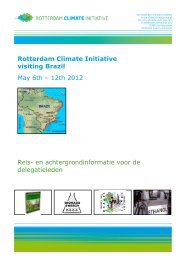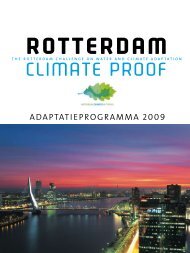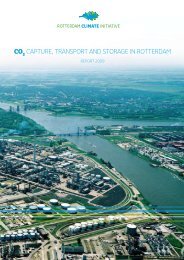Connecting Delta Cities (english) - Rotterdam Climate Initiative
Connecting Delta Cities (english) - Rotterdam Climate Initiative
Connecting Delta Cities (english) - Rotterdam Climate Initiative
You also want an ePaper? Increase the reach of your titles
YUMPU automatically turns print PDFs into web optimized ePapers that Google loves.
or system following the event through evacuation,<br />
recovery, fi nancial aid and insurance relief options.<br />
Estimates of fl ood risk and fl ood vulnerability can be<br />
further disaggregated into vulnerability to coastal<br />
fl oods, vulnerability to river fl oods and vulnerability<br />
to extreme rainfall. In all three cases the impact can<br />
be very high with numerous casualties and much<br />
damage to property.<br />
Extreme fl ood events are relatively rare, with typical<br />
return periods of one hundred years and higher.<br />
Extreme precipitation events in non-tropical cities<br />
rarely cause casualties, but do frequently cause<br />
damage to property and infrastructure. Tropical<br />
cities like Hong Kong, however, have interested<br />
historic events recorded where extreme rainfall has<br />
caused fl ash fl ooding and mud fl ows, leading to<br />
casualties and fl ood damage in parts of the cities.<br />
It should be noted that vulnerability is not a static<br />
concept. If fl ood protection is improved or evacuation<br />
plans are developed, vulnerabilities can be reduced;<br />
and, with expected advances in scientifi c modelling<br />
and prediction of storms and storm surges, improved<br />
warnings can be brought to bear in alerting<br />
communities at risk and in managing evacuations.<br />
Sea level rise alone may cause a presently one in a<br />
hundred years fl ood event to occur approximately<br />
four times more often by the end of the century.<br />
Moreover, by the end of the 21 st century, a current<br />
500-year fl ood event may occur approximately once<br />
every 200 years. G4<br />
The amount of damage from a fl ood is dependent on,<br />
among other factors, the size of the fl ooded area and<br />
the water depth. Other factors include the duration<br />
of the fl ood and fl ow velocities. Furthermore, the<br />
rate at which the water rises and the time allowed<br />
for evacuation largely determine the number of<br />
casualties. G7<br />
Flood damage and infrastructure<br />
Looking at the most important consequences of<br />
a fl ood for diff erent economic sectors, it appears<br />
most CDC cities are subject to similar threats from<br />
fl ooding, both from oceanic storm surges and from<br />
inland sources. For most ports, both land-based<br />
transportation and the use of inland waterways<br />
are of importance to connect the port areas with<br />
surrounding regions. These connections may be<br />
threatened as the clearance levels of bridges decrease<br />
during a fl ood. Train and subway stations may be<br />
fl ooded, coastal highways inundated, emergency<br />
and hospital services curtailed and communications<br />
disrupted. Furthermore, fl oods cause direct economic<br />
damage to infrastructure and property, with the<br />
magnitude of the damage depending on the depth<br />
and duration of the fl ood. Most estimates of fl ood<br />
damage rely on studies that quantify the direct<br />
economic damages only. However, other non-fl ooded<br />
areas may also be aff ected, as the supply of goods<br />
and services to the fl ooded area may be hindered.<br />
Production loss due to fl oods, however, is diffi cult to<br />
quantify at present. Indirect fl ood damage may be<br />
twice as high as the direct economic damage.<br />
C L I M A T E C H A N G E I N D E L T A C I T I E S 19







